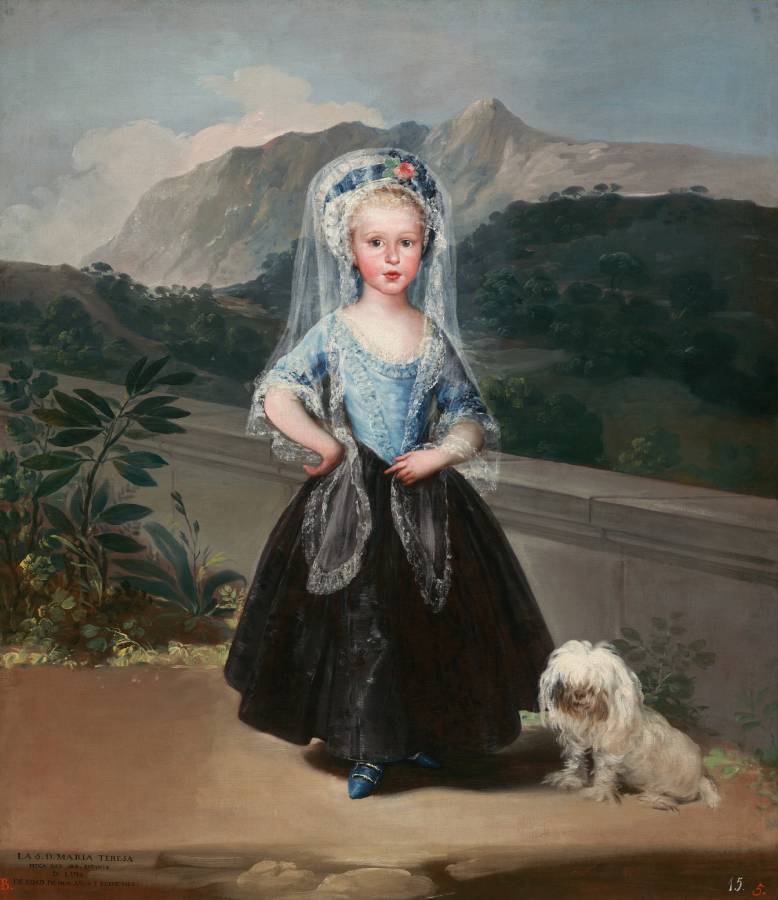Goya, Francisco de (1746-1828)
María Teresa de Borbón y Vallabriga
1783
Oil on canvas, 134.5 x 117.5 cm
National Gallery of Art, Washington
A young girl with pale skin, rosy cheeks, and blond hair stands facing us in front of a landscape with forests and mountains in this vertical portrait painting. The girl looks at us with wide, gray eyes under delicately arched eyebrows. She has a short, rounded nose, and her full, pink lips are parted. Her smooth, rounded cheeks are flushed. She wears a lace-trimmed, sky-blue, scoop-necked bodice that comes to a V at her waist, a full, ankle-length black skirt, and a white bonnet with a royal-blue ribbon, which has a pink rose at the bow. Her long, white, lacy veil, called a mantilla, drapes over the hat, over her shoulders, and to her waist. One end of the mantilla drapes over her left wrist, to our right. The other end is pinned under the back of her other hand, which rests against that hip. One cobalt-blue, pointed shoe with a silver buckle peeks out under her skirt. A small, shaggy, white-haired dog sits at her feet to our right. A low, gray stone wall behind the girl and dog angles away from us to the left. Some plants with dark green leaves grow in front of the wall to our left. Beyond the wall, pine-green, treed foothills rise to meet rocky, nickel-gray mountains under a ice-blue sky with pale, petal-pink clouds kicking up over the mountains. An inscription in all capital letters is painted in black in the lower left corner: “LA S.D. MARIA TERESA HIXA DEL SER. INFANTE D. LUIS DE EDAD DE DOS ANOS Y NUEVE MESES.” A crimson-red letter “B.” is painted to the left nearby. In the lower right corner, the number “15.” is painted in white and the number “5.” is painted in red. Lively and clever, the Spanish king’s eldest niece was just four-and-a-half years old when she posed for this portrait. Her confident stance and white lace mantilla (Spanish headdress) give the impression of maturity. The low viewpoint makes her look taller, as do the mountains in the background of the palace terrace. María Teresa’s father chose to marry below his rank, so the family was exiled to Ávila, Spain. They often invited artists to live with them there. Goya likely painted this portrait while staying at their home in August and September 1783. This was the first of four portraits that Goya would paint of María Teresa, who would later champion Spanish independence from France. Although Goya is now best known for his innovative and incisive depictions of such themes as the excitement of the bullring and horrors of the Napoleonic wars, it was as a portraitist that he first gained fame among his countrymen. In 1783, Goya was called to Arenas de San Pedro by the Infante Don Luis, brother of Charles III, to paint a family portrait. He also painted individual portraits of family members such as this one. Ingenuous but self-assured, the future countess wears the fashionable attire of a lady of the Spanish court as she poses at the edge of a terrace. She gazes out at the viewer with an innocence very much in contrast with her adult costume and mature stance. In the style of earlier “grand-manner” portraiture, Goya may have manipulated the setting to enhance the image of the diminutive sitter, perhaps adjusting the scale of the parapet to her size and placing the wall close to her. This is one of four portraits by Goya of María Teresa, with whom he maintained a lifelong sympathetic relationship. One of the most tragic figures at the court of Charles IV, the countess was trapped in a humiliating marriage to the King’s minister, Manuel Godoy, arranged by the Queen, Maria Luisa, for her own duplicitous purposes. (NGA)
See also:
• Borbón y Vallabriga, María Teresa de (1779-1828)
